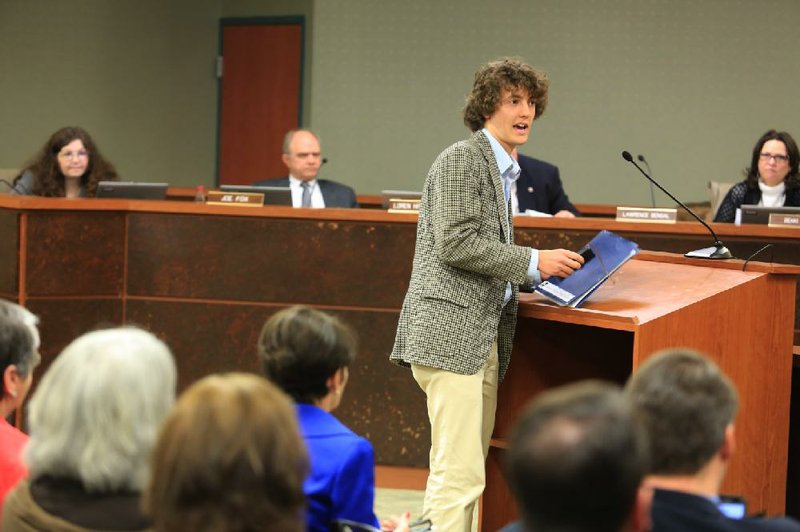Corrections: The Arkansas Department of Environmental Quality developed permitting guidelines for “concentrated animal feeding operations” in 2011. The term for the operations was incorrect in this article.
Commissioners with the Arkansas Pollution Control and Ecology Commission ordered Arkansas Department of Environmental Quality Director Teresa Marks on Friday to return in April with a plan to improve public notification of pending permits.
The department’s decision to approve a permit for a 6,500-animal hog farm inside the Buffalo National River watershed has drawn criticism from advocates for the Buffalo National River.
The directive, issued by commission Chairman Stan Jorgensen, came after two hours of public comment concerning a confined animal feeding operations general permit that the Environmental Quality Department issued to C&H Farms inMount Judea. Most of those protesting the permit addressed the potential dangers to the national river and the failure of the department to adequately notify the public that such a permit was under consideration.
At Friday’s meeting, Debbie Doss, conservation chairman for the Arkansas Canoe Club, summarized the complaints of about a dozen others, each of whom cited being taken by surprise by the issuance of the permit, despite being regularly engaged in public-policy participation.
“If no one here knows what’s going on, there’s something wrong with the notification process,” Doss said.
In 2010, the Environmental Quality Department began developing what is known asthe “confined animal feeding operations general permit” under the guidelines of the National Pollutant Discharge Elimination Systems program authorized by the federal Clean Water Act. The new permit requires operators to establish extensive retaining systems for animal waste and other byproducts, but also allows operators to discharge waste from animal confinement areas into public waterways in the event of extraordinary rainfall.
Between Feb. 11 and March 11, 2011, the department held six public-comment sessions around the state, during which comments from more than a dozen individuals, organizations and corporations were recorded. However, the review process concerned only the new confined animal feeding operations permit and had nothing to do with specific operations such as C&H Farms. The Arkansasconfined animal feeding operations general permit became effective Nov. 1, 2011.
C&H Farms was the first entity to apply for the new permit. Owners of the 670-acre farm, which is along the banks of Big Creek, a major tributary of the Buffalo River, completed a notice of intent to apply for the general permit in June 2012. While the notice of intent was posted on the Environmental Quality Department’s website, no further efforts were made to contact area residents or agencies about the permit application.
Interested parties can sign up to receive e-mail notifications from the department when it receives “notice of intent” applications for several kinds of permits, including permits for hazardous waste, solid waste and wastewater. According to department spokesman Katherine Benenati, an e-mail based mailing list that distributes information on applications for water permits under the National Pollutant Discharge Elimination Systems program was added to the site Feb. 19.
In August, the department issued the state’s first confined animal feeding operations general permit to C&H Farms, having received no public comment regarding the proposal.
Public outcry from environmental organizations and business owners who derive their income from tourism along the Buffalo National River began to mount after Kevin Cheri, superintendent of the river, expressed concern to Marks in a letter dated Dec. 20 over the National Park Service not being consulted during the permitting process for C&H Farms.
Marks responded to Cheri’s letter by explaining the history and process of creating the confined animal feeding operations general permit, rather than addressing specific information related to C&H Farms.
Marks told the commission Friday that during the process of gathering public comment on the state’s new general permit, administrators had no way of foreseeing an operation like C&H Farms.
“The problem is, nobody knew at that time that a [confined animal feeding operation] was going to go into the Buffalo River watershed,” Marks said.
“When that came out, that went on our website,” Marks said, referring to the noticeregarding C&H Farms. “And that’s what folks are saying they didn’t get. They feel that that was wrong, and I understand what they’re saying.”
Marks said she felt that despite public objections, greater public notice of the C&H Farms permit would not have changed the department’s decision to approve the permit.
“If you don’t want anything going into the Buffalo River watershed, then you need to look at how you can prevent discharges into the Buffalo River watershed. It’s that kind of issue. It’s not a notice issue,” Marks said. “As long as it’s legal for us to permit there, I don’t know how we would have denied this permit based upon what I have heard, because it’s a permitable facility under current law.”
Jorgensen told Marks to formulate a new approach to notifying the public to permit applications for presentationat the commission’s April 15 meeting.
“This process doesn’t work, not well,” Jorgensen said. “In this situation, for sure.”
After the meeting adjourned, Marks said a new process would likely concentrate on alerting county judges on a monthly basis to all new notices of intent that the department receives for affected counties.
Northwest Arkansas, Pages 9 on 03/23/2013

